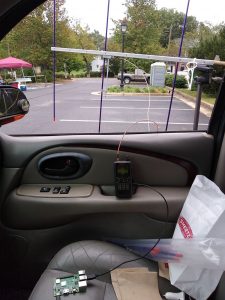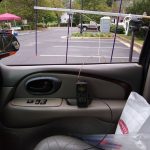Outside of things like packets bouncing off the ISS, APRS does have a legitimate use other than just playing around with packet. In fact, one of the original uses of APRS by it’s designer, Bob Bruninga, while a research engineer at the USNaval Academy in the 80s, was for plotting the positions of naval ships over HF. He later developed a more advanced version for tracking horses during a 100 mile endurance run. Of course, this was long before the use of GPS that allowed even more accurate position reporting along with automated beaconing. For the SOWW race, there was some very limited APRS usage; a few of the Nam Knights had APRS trackers placed on their motorcycles. The location of our race was quite rural, and there was question as to if the trackers on the motorcycles would be able to traverse the APRS infrastructure of digipeaters and iGates to make it back to the internet, where net control could get a look at it.
I decided to attempt to help by assembling a very quick-n-dirty APRS iGate. The software itself can be pretty simple to configure, most of the difficulty comes in interfacing your radio with a TNC that works on RaspberryPi. I figured from my position at Aldie, I could put my Arrow II yagi on a tripod, point it in the general direction of the rider’s loop, and hopefully nab a few packets directly from RF; the RPi would then send those directly to APRS-IS using a wifi connection available from my phone’s hotspot. I happen to have one tool (which was rather pricey) that made interfacing the radio with the RPi super easy; my Kenwood TH-D74. While the “most expensive HT on the market” does pack some nifty features like APRS and D-Star built in, it also features a KISS TNC that is available over a standard USB cable! No need to have a USB-to-Serial dongle like a number of radios; the Kenwood has all of this built-in to the radio. The drivers required to use this just also happen to be a standard part of the Rasberry Pi OS.
After booting a fresh installation of the OS, all I had to do was query the operating system for serial devices. Once I knew where I could reach the serial device presented by the Kenwood, it was just a matter of putting the radio into KISS TNC mode and configuring the software, aprx, to use the KISS TNC on the Kenwood’s “COM port”. That was it! Once the software booted up, it was happily accepting the data from the Kenwood’s TNC and processing it. A little extra configuration let me actually send these packets to APRS-IS, as well as set how often I wanted to beacon and if I wanted to act as an APRS-IS to RF gateway. There was another operator on the course who set up a portable digipeater, which should have eased my operation, in theory, as I could just point at his location and get his digipeated packets. In reality, my operation position meant my antenna didn’t want to hear him when I was “pointed at him”; but I was able to adjust the antenna so that I started seeing him. As soon as that happened, I began seeing those packets being reported to APRS-IS as having been uploaded from my iGate.
What impressed me was how well everything worked (excluding the operator not aiming his antenna right) despite how quickly and easily it went together. Having the Kenwood was a large help, I didn’t have to scramble to hack together a TNC on a breadboard and then fight with interfacing it in software. It was also very portable; my Kenwood TH-D74 ran on it’s own battery for the entire race and my RaspberryPi 3B+ ran all day off a half-charged 10,000mAh power bank. The only exception was leaving my smartphone plugged in to the car to power the hotspot. Even if it wound up not being necessary, it was very good exercise for possible future use. After looking over the software, one could easily build numerous cheap iGates and/or digipeaters to set up for an event in an area that might lack APRS coverage; or even running your own “APRS network” on a different frequency using nothing but digipeaters.

